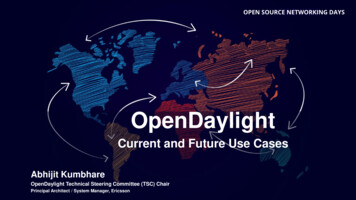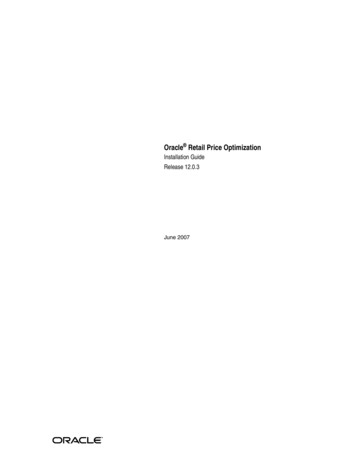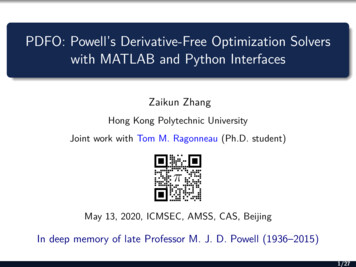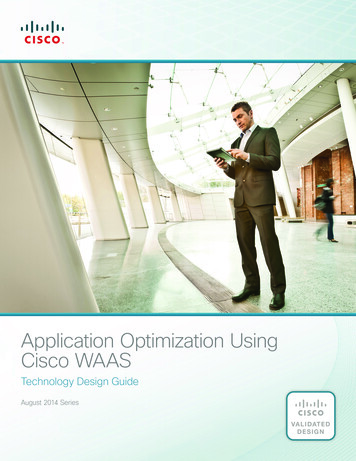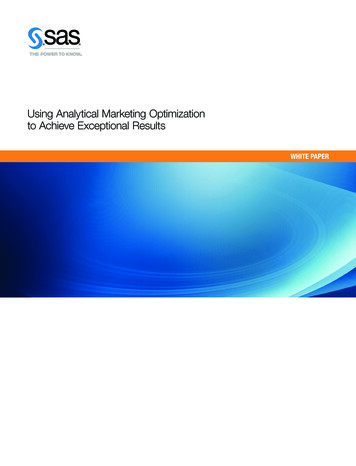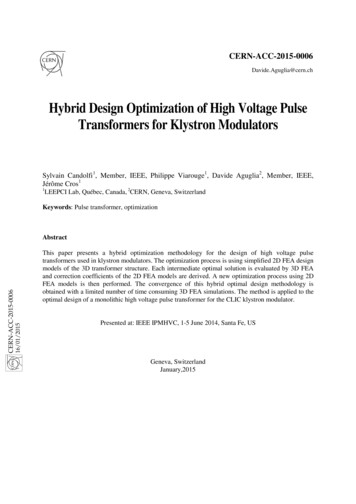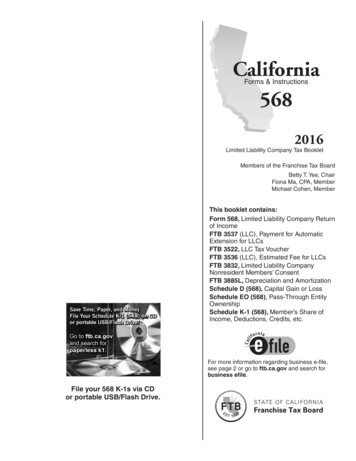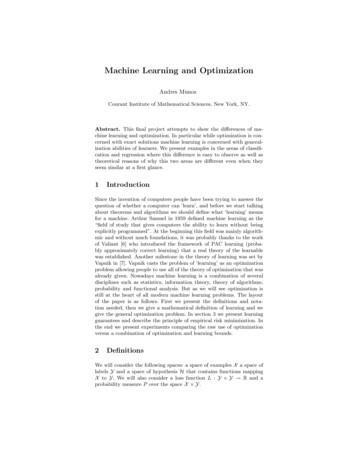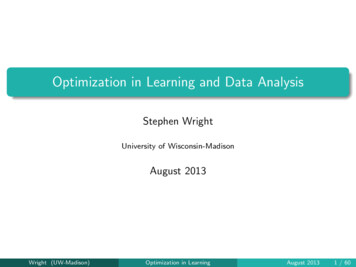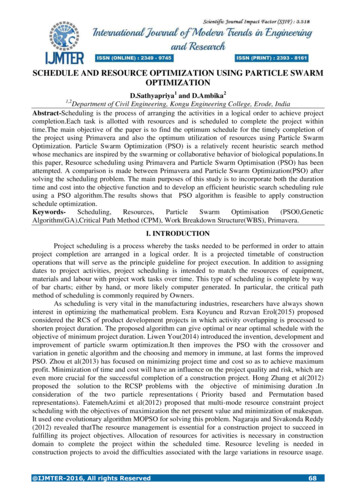
Transcription
SCHEDULE AND RESOURCE OPTIMIZATION USING PARTICLE SWARMOPTIMIZATIOND.Sathyapriya1 and D.Ambika2Department of Civil Engineering, Kongu Engineering College, Erode, IndiaAbstract-Scheduling is the process of arranging the activities in a logical order to achieve projectcompletion.Each task is allotted with resources and is scheduled to complete the project withintime.The main objective of the paper is to find the optimum schedule for the timely completion ofthe project using Primavera and also the optimum utilization of resources using Particle SwarmOptimization. Particle Swarm Optimization (PSO) is a relatively recent heuristic search methodwhose mechanics are inspired by the swarming or collaborative behavior of biological populations.Inthis paper, Resource scheduling using Primavera and Particle Swarm Optimisation (PSO) has beenattempted. A comparison is made between Primavera and Particle Swarm Optimization(PSO) aftersolving the scheduling problem. The main purposes of this study is to incorporate both the durationtime and cost into the objective function and to develop an efficient heuristic search scheduling ruleusing a PSO algorithm.The results shows that PSO algorithm is feasible to apply constructionschedule al Path Method (CPM), Work Breakdown Structure(WBS), Primavera.1,2I. INTRODUCTIONProject scheduling is a process whereby the tasks needed to be performed in order to attainproject completion are arranged in a logical order. It is a projected timetable of constructionoperations that will serve as the principle guideline for project execution. In addition to assigningdates to project activities, project scheduling is intended to match the resources of equipment,materials and labour with project work tasks over time. This type of scheduling is complete by wayof bar charts; either by hand, or more likely computer generated. In particular, the critical pathmethod of scheduling is commonly required by Owners.As scheduling is very vital in the manufacturing industries, researchers have always showninterest in optimizing the mathematical problem. Esra Koyuncu and Rızvan Erol(2015) proposedconsidered the RCS of product development projects in which activity overlapping is processed toshorten project duration. The proposed algorithm can give optimal or near optimal schedule with theobjective of minimum project duration. Liwen You(2014) introduced the invention, development andimprovement of particle swarm optimization.It then improves the PSO with the crossover andvariation in genetic algorithm and the choosing and memory in immune, at last forms the improvedPSO. Zhou et al(2013) has focused on minimizing project time and cost so as to achieve maximumprofit. Minimization of time and cost will have an influence on the project quality and risk, which areeven more crucial for the successful completion of a construction project. Hong Zhang et al(2012)proposed the solution to the RCSP problems with the objective of minimising duration .Inconsideration of the two particle representations ( Priority based and Permutation basedrepresentations). FatemehAzimi et al(2012) proposed that multi-mode resource constraint projectscheduling with the objectives of maximization the net present value and minimization of makespan.It used one evolutionary algorithm MOPSO for solving this problem. Nagaraju and Sivakonda Reddy(2012) revealed thatThe resource management is essential for a construction project to succeed infulfilling its project objectives. Allocation of resources for activities is necessary in constructiondomain to complete the project within the scheduled time. Resource leveling is needed inconstruction projects to avoid the difficulties associated with the large variations in resource usage.@IJMTER-2016, All rights Reserved68
International Journal of Modern Trends in Engineering and Research (IJMTER)Volume 03, Issue 04, [April – 2016] ISSN (Online):2349–9745; ISSN (Print):2393-8161Fang Xu, Xin Zhanhong (2012) presented a new approach for construction resource optimization.This paper have been showed the PSO can be applied to more general problems without greatdifficulty. Mehdi Tavakolan(2011) presents the comprehensive model of Time-Cost-ResourceOptimization in terms of obtaining the shortest duration, the least project cost, and the leastresource moments in the least time and the fewest number of iterations.According to the project size,It evaluate the significant parameters of each algorithm to obtain the optimal project schedulesolutions. Emad Elbeltagia et al(2005) revealed that the comparative study of five evolutionarybased search methods (GA, MA, PSO, ACO, and SFL) were presented. A brief description of eachmethod is presented along with a pseudo code to facilitate their implementation.Among fivemethods, The PSO method was found to perform better than other algorithms in terms of successrate and solution quality, processing time. Hong Zhang et al (2005) revealed that the theory of PSOhas been proposed for solving the RCPSP with the objective of minimizing project duration.Thepermutation-based sequence of the activities is described by the multidimensional particle.Theproposed PSO shows some advantages over GA, such as “one-way” sharing of the local best and theglobal best experiences during the search process and easy adjusting of a few parameters for satisfiedresults. Natasa Prascevic, Zivojin Prascevic(2005) proposed that the particle swarm optimizationmethod can successfully be used for optimising realization of construction projects.This paper haveadopted this method for solving these problems, taking into account project costs, activity durations,and activity correlations in the critical path diagram.Comparing the above papers, this paper is unique in the sense that it considers multipleprocessing lines and CS, PSO and hybrid CS-PSO is used to schedule the jobs in multiple processinglines.This paper is organized as follows. Scheduling is discussed in 2.Primavera Project planner isdiscussed in section 3.Particle Swarm Optimization algorithm is discussed in Section 4. Themethodology of this paper is discussed in section 5. Section 6 contains the performance comparison,results and discussion. The conclusion of this paper is given in section 7.II. SCHEDULINGProject scheduling is a process whereby the tasks needed to be performed in order to achieveproject completion are arranged in a logical order. It is a projected timetable of constructionoperations that will serve as the principle guideline for project execution. In addition to assigningdates to project activities, project scheduling is intended to match the resources of equipment,materials and labour with project work tasks over time. This type of scheduling is done by way ofbar charts; either by hand, or more likely computer generated. In particular, the critical path methodof scheduling is commonly required by owners.The project schedule is a calendar that links the tasks to be done with the resources that willdo them.Developing network plan from these activities and separate calendar is created for theproject scheduling. The calendar used in the project is of 6 days in a week and 10 hours per day.The network shows the sequences and interdependence of activities, their time duration andtheir earliest start time and latest completion time. The start time and commencement of activities aregiven in the Primavera. After scheduling the project, it is possible to determine commencement andtermination date of each activity.First the Work Break Structure(WBS) is fed into the software. The activity and their durationare given as inputs in the Primavera Project Planner.The relationship between the activities are givenusing relationship option. Before scheduling, starting date of the project is given. After running,theproject total duration arrived is given. It is the determination of the timing and sequence ofoperations in the project and to gives the overall completion time.The main purpose of the scheduling is to optimize the resources in which it is required for thecompletion of the project.@IJMTER-2016, All rights Reserved69
International Journal of Modern Trends in Engineering and Research (IJMTER)Volume 03, Issue 04, [April – 2016] ISSN (Online):2349–9745; ISSN (Print):2393-8161III. PRIMAVERA PROJECT PLANNERProject planning management tool developed by primavera system inc.in 1983.Primaveraproject planner(P3) is the first software released by primavera. The latest version is P6.8.Primaverais designed to handle large-scale, highly sophisticated and multifaceted projects. The modules areProject Management, Methodology Management & My Primavera.Primavera P6 offers an easy-to-use approach to project planning with an intuitive interfacethat makes project planning and control easy,without sacrificing the powerful sophistication of highend project-management software that you expect from primavera.The Primavera integratedconstruction management solution provides Role-based dashboards Productivity-based Forecasts Easy-to-read graphical trends custom reportsPrimavera is an integrated product that goes far beyond scheduling providing you withadvanced collaboration tools, action alerts and centralized project information.The information fromWBS and logic Network can be input into a software package such as primavera 6 to provide adetailed plan. Enter the tasks, predecessors, resources and time estimates into the software. Onceentered, the software will create the charts and graphs automatically.Primavera P6 helps identify andmitigate risks in the course of planning, managing, and completing a project. Primavera P6 allows allinvolved in a project to carefully monitor resource availability and adjust such resources to meetproject demands. Primavera helps to determine the schedule of the activities and relationshipbetween the activities. Scheduling also provides comparison of actual progress against planand help identify deviations from plan. Scheduling also enables early corrective actions andadjustments to plan.IV. PARTICLE SWARM OPTIMZATIONParticle swarm optimization (PSO) is a population based heuristic global optimizationmethod and it was developed by Kennedy and Eberhart in 1995. It is developed from swarmintelligence and is based on the research of collective behaviour of bird and fish. When the birds aresearching for food, they are either in different direction or at the same direction before they areidentifying the place where the food is present. While the birds are searching for food from one placeto another, one bird among the group can smell the place where the food is available and having thebetter food resource information. This information will be conveyed to all other birds and based onthe quality of the information all other birds will update their direction and velocity towards the birdwhich is having better food resource information. As far as particle swam optimization algorithm isconcerned, all the possible solutions are considered as birds which searching for a food and goodinformation is equal to the optimum solution. The most optimum solution can be finding out in PSOalgorithm by the cooperation of each individual particle. PSO consists of a swarm of particlesmoving in an n-dimensional problem with n-solutions. Every particle „i‟ at the time„t‟ has thefollowing characteristics: Xi,t,Vi,t are the position and the velocity vectors Pi,t is the small memory storing its own best position Gi,t is the global best positionAt each time step t, the velocity is updated and the particle is moved to a new position. Thisnew position is calculated as the sum of previous position and the new velocityThe update of the velocity is determined with the following relation@IJMTER-2016, All rights Reserved70
International Journal of Modern Trends in Engineering and Research (IJMTER)Volume 03, Issue 04, [April – 2016] ISSN (Online):2349–9745; ISSN (Print):2393-8161Where ω is the inertia weight that controls the impact of the previous velocity on the currentvelocity by balancing of exploration and exploitation characteristic of an algorithm.Each particle keeps track of its coordinates in the problem space which are associated withthe best solution (fitness) it has achieved so far. (The fitness value is also stored.) This value is calledpbest. Another "best" value that is tracked by the particle swarm optimizer is the best value, obtainedso far by any particle in the neighbors of the particle. This location is called lbest. when a particletakes all the population as its topological neighbors, the best value is a global best and is called gbest.Particle Swarm Optimization (PSO) is a relatively recent heuristic search method that isbased on the idea of collaborative behavior and swarming in biological populations. PSO is similar tothe Genetic Algorithm (GA) in the sense that they are both population-based search approaches andthat they both depend on information sharing among their population members to enhance theirsearch processes using a combination of deterministic and probabilistic rules. Conversely, the GA isa well established algorithm with many versions and applications.Particle swam optimization is a new heuristic optimization method based on swarmintelligence. Compared with the other algorithms, the method is very simple, easily completed and itneeds fewer parameters, which made it fully developed. However, the research on the PSO is still atthe beginning, a lot of problems are to be resolved. PSO has shown its fast search speed in manycomplicated optimization and search problems.The main objective is to determine the optimum duration and cost by various iterations .ThePSO algorithm is designed by MATLAB Programming or C Programming.V. METHODOLOGYooooooooooLiterature collection for the project.Problem definition and objective definition.Study on different optimization techniques.i.e.Genetic Algorithm(GA),Particle Swarm optimization(PSO) techniques, Artificial NeuralNetwork(ANN).Selection of optimization techniques and design project.Identification of the activities and resources allocation for the activities.Scheduling the activities using primavera project planner.Optimization of resources using Particle Swarm optimization.Comparison between Primavera and PSO.Results and conclusion.@IJMTER-2016, All rights Reserved71
International Journal of Modern Trends in Engineering and Research (IJMTER)Volume 03, Issue 04, [April – 2016] ISSN (Online):2349–9745; ISSN (Print):2393-8161VI. RESULTS AND DISCUSSIONSThe Scheduling using Primavera and PSO are developed in this paper.The PSO algorithm isdesigned in MATLAB programming and are made to run for different iterations.The algorithm ismade to run for iterations and the results are compared to get optimal solution.Results of Primavera :Table Scheduling of the projectProjectDurationStart dateFinishdate25 July20162ndNovember2015The total number of activities 56Residentialbuilding277The figure shows the scheduling of the project with activities and its duration usingPrimavera Project Planner.This figure represents the major activities of the project.It contains the sub activities of the project.This figure represents the Work Breakdown Structure.It contains the activity of the project and itsproject status.@IJMTER-2016, All rights Reserved72
International Journal of Modern Trends in Engineering and Research (IJMTER)Volume 03, Issue 04, [April – 2016] ISSN (Online):2349–9745; ISSN (Print):2393-8161This figure represents the sequence of the activities and its relationship.It contains the start and finishdate of the activities.Results of PSO:DetailsDurationCost ofprojectPrimavera277the 35,00,000PSO22025,00,000VII. CONCLUSIONSSwarm intelligence-based algorithms such as particle swarm optimization are very efficientin solving a wide range of nonlinear optimization problems. The algorithm are implementedsuccessfully for solving the scheduling optimization problem. Results obtained from Primavera andPSO are compared and the performances are analysed. PSO is found to be superior and givesOptimum duration and minimum cost of the project. In the future, this work may be further extendedfor solving scheduling problems in the construction projects.REFERENCES[1] Amer Fahmy , Tarek M. Hassan and Hesham Bassioni(2014) „ Improving RCPSP solutions quality with StackingJustification – Application with particle swarm optimization ‟Journal of 'Expert Systems with Applications Vol.41pp. 5870–5881.[2] Esra Koyuncu and Rızvan Erol(2015) „PSO based approach for scheduling NPD projects including overlappingProcess‟ Computers & Industrial Engineering Vol. 85 pp. 316–327.[3] Emad Elbeltagia Tarek Hegazy and Donald Grierson(2005) „Comparison among five evolutionary-basedoptimization algorithms‟ Advanced Engineering Informatics Vol. 19 pp. 43–53.[4] Eberhart.R., and Shi. Y(1998) „Comparison between Genetic Algorithms and Particle SwarmOptimization‟,Evolutionary Programming VII Vol. 1447 pp. 611-616.[5] FatemehAzimi, Razeeh Sadat Aboutalebi and Amir Abbas Najafi(2011) „Using Multi-Objective Particle SwarmOptimization for Bi-objective Multi-Mode Resource-Constrained Project Scheduling Problem‟ World Academy ofScience Engineering and Technology Vol. 5 pp. 06-25.[6] Georgios Koulinas (2014) „A particle swarm optimization based hyper-heuristic algorithm for the classic resourceconstrained project scheduling problem‟ Journal of Information Sciences Vol. 277 pp.680–693.@IJMTER-2016, All rights Reserved73
International Journal of Modern Trends in Engineering and Research (IJMTER)Volume 03, Issue 04, [April – 2016] ISSN (Online):2349–9745; ISSN (Print):2393-8161[7] Graham Kendall and Yan Su(2005) „A Particle Swarm Optimisation Approach In The Construction Of OptimalRisky Portfolios‟ Artificial intelligence and Applications pp.140-145.[8] Hong Zhang, Xiaodong Li, Heng Li, Fulai Huang(2005), „Particle swarm optimization-based schemes for resourceconstrained project scheduling‟ Automation in Construction Vol. 14 pp.393– 404.[9] Hong Zhang, Heng Li and C. M. Tam(2009), „Permutation-Based Particle Swarm Optimization for ResourceConstrained Project Scheduling‟, Journal of computing in civil engineering Vol. 20 pp.141- 149.[10] J Zhou, PED Love, X Wang, KL Teo and Z Irani(2013) „A review of methods and algorithms for optimizingconstruction scheduling‟ Journal of the Operational Research Society Vol. 64 pp.1091–1105.[11] Ming Lu , Hoi-Ching Lam, Fei Dai(2008) „Resource-constrained critical path analysis based on discrete eventsimulation and particle swarm optimization‟ Automation in Construction Vol. 17 ,pp.670–681.[12] Natasa Prascevic , Zivojin Prascevic(2014) „Application of particle swarms for project time-cost optimization‟Journal of Gradevinar Vol. 66,pp. 1097-1107.[13] SK. Nagaraju, B. Sivakonda Reddy(2012) „Resource Management in Construction Projects – a case study‟ AnInternational Journal (ESTIJ) Vol. 2, pp.660-665.@IJMTER-2016, All rights Reserved74
PRIMAVERA PROJECT PLANNER Project planning management tool developed by primavera system inc.in 1983.Primavera project planner(P3) is the first software released by primavera. The latest version is P6.8.Primavera is designed to handle large-scale, highly sophisticated and multifaceted projects. The modules are
